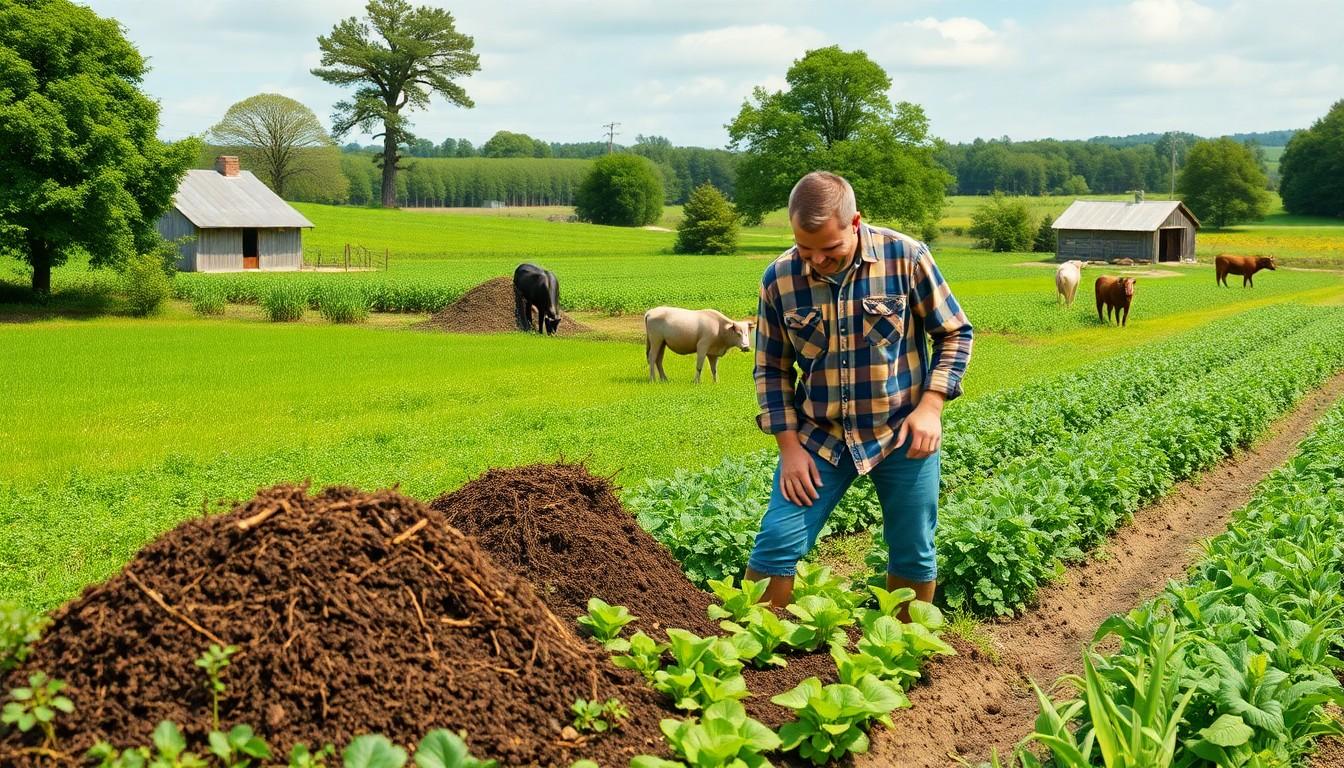The Best Fluffy Pancakes recipe you will fall in love with. Full of tips and tricks to help you make the best pancakes.

Regenerative Agriculture Practices: Transform Your Farm and Heal the Planet
Imagine a world where farming isn’t just about harvesting crops but also about healing the planet. Regenerative agriculture practices are here to turn that dream into reality. By focusing on soil health and biodiversity, these innovative methods not only boost yields but also combat climate change. It’s like giving Mother Earth a much-needed spa day while still filling up those grocery carts.
Regenerative Agriculture Practices
Regenerative agriculture involves practices that restore soil health and enhance biodiversity. Key methods include cover cropping, which prevents soil erosion and improves nutrient retention. Crop rotation enhances soil fertility and pest management, disrupting the life cycles of pests and diseases.
Integrating livestock into cropping systems promotes nutrient cycling and improves soil structure. Practices such as agroforestry combine trees and shrubs with crops, which supports wildlife habitats and increases carbon sequestration. No-till farming reduces soil disturbance, safeguarding microorganisms essential for soil health.
Composting adds organic matter back to the soil, enhancing microbial activity and water retention. Monitoring soil health through regular testing helps farmers understand nutrient needs and improve their management practices. Integrated pest management employs biological control methods, reducing reliance on chemical pesticides.
Maintaining diverse cropping systems minimizes risks related to market fluctuations and climate variability. Implementing these practices contributes not only to improved yields but also to enhanced ecosystem services. Farmers adopting regenerative practices report increased resilience against extreme weather events, further affirming the benefits of these approaches.
Overall, regenerative agriculture creates a holistic framework that supports sustainable farming by prioritizing ecological balance while ensuring productive yields.
Key Principles of Regenerative Agriculture

Regenerative agriculture focuses on enhancing ecological health through specific practices. Key principles emphasize soil health and biodiversity, contributing to sustainable farming.
Soil Health Enhancement
Soil health enhancement forms the foundation of regenerative agriculture. Improved soil structure and increased organic matter lead to better water retention and nutrient availability. Regular addition of compost and cover crops maintains soil fertility. Microbial diversity also benefits through healthy soil processes, fostering resilience against pests and diseases. Farmers utilize practices like rotational grazing and no-till systems to prevent soil erosion. Enhanced nutrient cycling and carbon sequestration become possible with these methods, promoting overall ecosystem functionality.
Biodiversity Promotion
Biodiversity promotion remains essential in regenerative agriculture. Diverse crop rotations enhance soil resilience and reduce pest outbreaks. Integrating livestock into cropping systems fosters symbiotic relationships, increasing overall farm productivity. Native plants support pollinators and beneficial insects, contributing to ecological balance. Agroforestry practices create habitats for various organisms, enriching farm biodiversity. Farmers thereby mitigate risks stemming from climate variability and ensure sustainable yields. Healthy ecosystems thrive, ultimately benefiting both agriculture and the environment.
Benefits of Regenerative Agriculture Practices
Regenerative agriculture practices provide significant benefits for the environment and the economy, fostering a sustainable approach to farming.
Environmental Impact
Improving soil health stands as a primary environmental benefit. Practices enhance biodiversity by restoring native ecosystems and promoting a balance among various species. Regenerative agriculture also mitigates climate change effects through carbon sequestration, capturing carbon dioxide from the atmosphere and storing it in the soil. Water retention improves as organic matter increases, reducing runoff and flooding risks. Enhancing soil structure supports microbial communities, which play crucial roles in nutrient cycling. Ultimately, these practices promote healthier ecosystems that support wildlife and increase resilience against extreme weather events.
Economic Advantages
Farmers experience various economic advantages through regenerative practices. Increased crop yields stem from improved soil fertility, leading to higher profits. Reduced reliance on chemical inputs lowers operational costs, enhancing overall profitability. Crop diversity minimizes risks associated with market fluctuations, ensuring stable income streams. Additionally, regenerative farmers often access premium markets that prioritize sustainable sourcing, boosting revenue potential. Long-term sustainability can improve land value, providing economic security for future generations. Adopting these practices fosters a financially viable farming strategy while contributing positively to the larger agricultural landscape.
Challenges in Implementing Regenerative Agriculture
Implementing regenerative agriculture presents various challenges that farmers encounter, often requiring significant adjustments to traditional practices.
Initial Investment
Initial investment remains a prominent barrier for many farmers. Transitioning to regenerative methods often requires expenditures on new equipment, cover crops, and soil amendments. Without immediate economic returns, many hesitate to commit financially. Studies show that upfront costs can reach $500 per acre for certain regenerative practices. Over time, the benefits such as improved soil health and reduced inputs may offset these expenses, but immediate financial pressures often cause concern.
Knowledge and Training
Knowledge and training play a crucial role in successful implementation. Farmers often lack access to information on regenerative techniques, making it difficult to adopt these practices effectively. Educational resources and workshops are essential for providing guidance. According to the USDA, only 27% of farmers have received formal training on sustainable practices. Increased investment in educational programs can empower farmers to embrace regenerative agriculture, ensuring they understand the methods and the long-term benefits associated with them.
Case Studies of Successful Regenerative Agriculture Practices
Successful examples of regenerative agriculture demonstrate the practical benefits of innovative practices. One notable case is the Rodale Institute in Pennsylvania, which has achieved significant results by implementing no-till farming and cover cropping. Over 30 years of research show enhanced soil health, with increases in organic matter and improved crop yields by up to 40%.
Another impressive example comes from White Oak Pastures in Georgia. This farm utilizes holistic planned grazing, resulting in better pasture management and increased biodiversity. Livestock integrate seamlessly into the cropping system, improving nutrient cycling and promoting healthier soils.
In Australia, the Savory Institute showcases the success of regenerative practices through its farmer training programs. Farmers participating in these programs report reduced erosion and increased water retention, leading to significant improvements in crop resilience. Increased organic matter also contributes to higher productivity and greater profitability.
The study of Flying Sky Farm in Oregon highlights the role of agroforestry in enhancing crop diversity. By incorporating fruit trees and shrubs alongside traditional crops, this farm has boosted biodiversity and improved pest management. Crop yields have increased thanks to reduced pest outbreaks, demonstrating the effectiveness of this practice.
Lastly, Kiss the Ground, a nonprofit organization, encourages farmers to adopt regenerative practices as a means to combat climate change. The organization’s initiatives in California show reduced greenhouse gas emissions while enhancing soil health. Farmers report the potential for carbon credits, providing additional economic incentives for transitioning to regenerative methods.
These case studies illustrate the wide-ranging benefits of successful regenerative agriculture practices, emphasizing the positive impact on soil health, biodiversity, and economic viability.
Sustainable Farming
Regenerative agriculture offers a promising path toward sustainable farming that prioritizes both ecological health and economic viability. By embracing practices that restore soil health and enhance biodiversity, farmers can create resilient systems capable of withstanding climate challenges. The shift toward these innovative methods not only improves crop yields but also fosters a healthier planet.
While obstacles exist, such as initial investments and the need for education, the long-term benefits of regenerative practices far outweigh the challenges. As more farmers adopt these techniques, the collective impact on ecosystems and communities will become increasingly evident. The future of agriculture lies in regeneration, paving the way for a sustainable and prosperous agricultural landscape.
